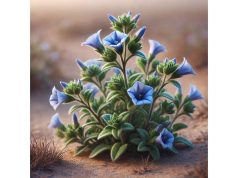
Ecballium, most famously represented by the species Ecballium elaterium, is a remarkable herbaceous plant belonging to the Cucurbitaceae family. Commonly known as the “squirting cucumber” or “exploding cucumber,” this fascinating botanical marvel is native to the Mediterranean region and parts of Southwest Asia. With its unique mechanism of seed dispersal—where mature fruits violently eject their watery, seed-laden contents—it has captivated botanists, herbalists, and naturalists alike. Historically, Ecballium has been used in traditional medicine for its potent bioactive compounds, notably cucurbitacins, which are believed to offer anti-inflammatory, purgative, and expectorant properties. Despite its toxic potential when misused, controlled applications have rendered it a subject of keen scientific interest and traditional remedy.
Ecballium’s intriguing morphology, combined with its storied history in folk medicine, positions it as a subject of both cultural importance and modern research. Its distinctive fruit, which literally “squirts” its seeds upon maturity, serves as a natural marvel that underscores the complexity of plant evolution. Over the centuries, traditional healers have harnessed its properties to alleviate ailments such as sinusitis, congestion, and digestive disorders. Today, Ecballium is at the crossroads of ancient wisdom and modern science, as researchers continue to investigate its chemical constituents and potential therapeutic applications.
- Offers unique bioactive compounds with potential anti-inflammatory and expectorant properties
- Traditionally used in Mediterranean folk medicine for sinusitis, congestion, and digestive support
- Exhibits a distinctive seed dispersal mechanism that has intrigued scientists and naturalists
- Represents a bridge between ancient herbal practices and modern pharmacological research
- Holds potential for future development into novel therapeutic agents when used responsibly
Table of Contents
- Ecballium Botanical Profile and Unique Morphology
- Ecballium Historical Context and Cultural Legacy
- Ecballium Phytochemical Composition and Bioactive Constituents
- Ecballium Health Benefits and Natural Properties
- Ecballium Uses, Applications, and Safety Considerations
- Ecballium Research Insights and Recent Scientific Studies
- Ecballium Frequently Asked Questions (FAQ)
Ecballium Botanical Profile and Unique Morphology
Ecballium, particularly Ecballium elaterium, is a perennial herb that thrives in the warm, sun-drenched environments of the Mediterranean basin and adjoining regions. Characterized by its sprawling growth habit and distinctive fruiting bodies, Ecballium is a testament to the ingenuity of nature’s reproductive strategies.
Taxonomy and Classification
- Family: Cucurbitaceae
Ecballium is a member of the cucumber family, which includes a diverse range of gourds, melons, and squashes. - Genus: Ecballium
This genus comprises several species, with Ecballium elaterium being the most well-known for its remarkable fruit dispersal mechanism. - Common Names:
Often referred to as the “squirting cucumber” or “exploding cucumber,” these names reflect the plant’s most striking feature.
Morphological Characteristics
- Growth Habit:
Ecballium typically exhibits a low-growing, trailing habit with sprawling vines that extend across the ground. Its growth is well-suited to rocky, well-drained soils often found in arid and semi-arid regions. - Leaves:
The leaves are broadly ovate to heart-shaped, with a rough texture and a slightly waxy surface that helps conserve moisture. Their green hue provides a vibrant contrast against the brownish, fibrous stems. - Flowers:
Small and inconspicuous, the flowers of Ecballium are typically yellowish or greenish in color. They form in clusters and serve as the precursors to the plant’s most dramatic feature—the fruit. - Fruit:
The fruit of Ecballium is a large, bladder-like capsule that matures to an impressive size relative to the plant. When fully ripe, the fruit builds up internal pressure and ejects its seeds forcefully in a process that can project the seeds several feet away. This “squirting” action not only aids in seed dispersal but also has fascinated observers for centuries.
Ecological Adaptations
Ecballium’s unique morphology is a direct adaptation to its often challenging natural habitats. The explosive seed dispersal mechanism is a clever evolutionary strategy that maximizes the plant’s ability to colonize new areas. In environments where competition for resources is fierce, this trait ensures that seeds are spread over a wide area, reducing the likelihood of overcrowding and increasing the chances of successful germination.
Furthermore, the robust, sprawling vines of Ecballium help stabilize the soil, reducing erosion in areas prone to dryness and wind. This ecological function underscores the plant’s importance not only as a source of potential medicinal compounds but also as a contributor to the stability of its native ecosystems.
Ecballium Historical Context and Cultural Legacy
The history of Ecballium is as dynamic and explosive as its fruit. For centuries, this remarkable plant has been woven into the cultural fabric of the Mediterranean and beyond, revered not only for its unique biological traits but also for its significant role in traditional medicine.
Traditional Medicinal Uses
- Ancient Remedies:
In ancient Greek and Roman texts, Ecballium was often mentioned as a potent remedy for a variety of ailments. Traditional healers used extracts from its fruit, leaves, and even the sap to treat conditions such as sinusitis, nasal congestion, and digestive disturbances. Its strong purgative properties, while dangerous in large doses, were believed to cleanse the body and expel toxins. - Folk Medicine Practices:
Throughout history, rural communities in the Mediterranean have employed Ecballium in their folk medicine traditions. The plant was typically prepared as a decoction or infusion, with small doses administered to alleviate symptoms associated with respiratory ailments and to stimulate digestive processes. - Symbolic Significance:
Beyond its practical applications, Ecballium also held a symbolic role in various cultural rituals. Its explosive seed dispersal was often seen as a metaphor for renewal and the cyclical nature of life. In some local traditions, the plant was associated with fertility and rebirth, celebrated during seasonal festivals.
Trade and Cultural Exchange
The medicinal properties of Ecballium did not remain confined to local practices. As trade routes expanded throughout the Mediterranean, knowledge of this potent herb spread to distant lands. Arab scholars and physicians in medieval times documented its use, integrating it into their extensive pharmacopeias. This cross-cultural exchange enriched the understanding of Ecballium’s benefits and paved the way for further scientific inquiry into its properties.
Shifts in Perception Over Time
In more recent centuries, as modern medicine began to dominate, traditional uses of Ecballium fell out of favor due to concerns over its toxicity and the risks associated with improper dosage. However, a resurgence of interest in natural and alternative remedies has led researchers and herbalists to re-examine the plant’s historical applications. Contemporary studies are now shedding light on the mechanisms behind its therapeutic effects, offering the possibility of harnessing its benefits in a controlled, scientifically validated manner.
Ecballium Phytochemical Composition and Bioactive Constituents
At the heart of Ecballium’s therapeutic potential lies a complex array of phytochemicals. These bioactive constituents not only underpin its traditional medicinal uses but also offer promising avenues for modern pharmacological research.
Major Bioactive Compounds
- Cucurbitacins:
One of the most significant groups of compounds found in Ecballium is the cucurbitacins. These highly oxygenated triterpenoids are known for their potent anti-inflammatory and cytotoxic properties. In small, controlled doses, cucurbitacins have been explored for their potential anticancer activities, though their inherent toxicity demands cautious handling. - Glycosides:
Ecballium contains several glycosides, which are compounds where sugar molecules are bonded to other functional groups. These glycosides may contribute to the plant’s purgative effects, a characteristic that was both revered and feared in traditional medicinal systems. - Flavonoids and Phenolic Acids:
Like many medicinal plants, Ecballium is also rich in flavonoids and phenolic acids. These compounds exhibit strong antioxidant activity, helping to neutralize free radicals and reduce oxidative stress in cells. Their presence supports the plant’s use in treating inflammatory conditions and enhancing overall cellular health. - Volatile Oils:
Although present in smaller quantities, the essential or volatile oils of Ecballium contribute to its distinctive aroma and may have mild antimicrobial properties. These oils can play a supportive role in traditional remedies aimed at respiratory or sinus-related issues.
Synergistic Interactions
The therapeutic effects of Ecballium are not attributable to any single compound; rather, they emerge from the synergistic interactions among its diverse bioactive constituents. When used in traditional remedies, the combined action of cucurbitacins, glycosides, flavonoids, and volatile oils enhances their overall efficacy. Modern extraction techniques, such as high-performance liquid chromatography (HPLC) and gas chromatography-mass spectrometry (GC-MS), are now employed to profile these compounds accurately and to explore their potential in standardized formulations.
Implications for Modern Medicine
Understanding the phytochemical composition of Ecballium is crucial for bridging the gap between traditional knowledge and modern therapeutic applications. With continued research, there is potential to isolate specific compounds that can be used safely in targeted treatments, particularly for inflammatory and respiratory conditions. However, the inherent toxicity of some components, notably cucurbitacins, necessitates rigorous clinical testing and precise dosage formulations to ensure patient safety.
Future Research Directions
Future studies on Ecballium are likely to focus on:
- Isolating individual cucurbitacins and elucidating their mechanisms of action
- Conducting pharmacokinetic studies to determine optimal dosage and delivery methods
- Investigating the synergistic effects of the plant’s full phytochemical profile in various therapeutic contexts
- Evaluating the potential for developing new drugs based on Ecballium’s bioactive compounds while minimizing toxicity
Ecballium Health Benefits and Natural Properties
Ecballium has long been valued in traditional medicine for its wide-ranging therapeutic benefits. Modern research is beginning to validate many of these historical applications, shedding light on how its bioactive compounds can support health and well-being.
Therapeutic Properties
- Anti-Inflammatory Effects:
The cucurbitacins and other bioactive compounds in Ecballium have demonstrated significant anti-inflammatory properties in experimental studies. This makes the plant a potential candidate for managing conditions characterized by chronic inflammation, such as arthritis and certain respiratory ailments. - Expectorant and Purgative Actions:
Traditional uses of Ecballium include its role as an expectorant, helping to clear mucus and alleviate symptoms of sinusitis and bronchitis. Additionally, its mild purgative effect has been utilized to stimulate digestive motility and cleanse the gastrointestinal tract. These properties, however, must be approached with caution due to the risk of toxicity. - Antioxidant Support:
The flavonoids and phenolic acids present in Ecballium contribute to its antioxidant capacity. By neutralizing harmful free radicals, these compounds may help reduce oxidative stress, thereby supporting immune function and potentially lowering the risk of chronic diseases. - Potential Anticancer Activity:
Preliminary studies have suggested that the cucurbitacins in Ecballium might exhibit cytotoxic effects against certain cancer cell lines. While these findings are promising, extensive clinical research is required to determine the safety and efficacy of such applications.
Holistic Health Impact
Beyond its direct therapeutic effects, Ecballium is believed to contribute to holistic well-being. Its use in traditional medicine is often integrated with other lifestyle and dietary practices that promote balance and vitality. The plant’s unique properties are said to support not only physical health but also mental clarity and energy levels—a holistic approach that aligns with many modern integrative medicine practices.
Cautions and Contraindications
It is essential to note that despite its potential benefits, Ecballium carries significant risks if used improperly. The same compounds that offer therapeutic benefits can be highly toxic in excessive doses. Traditional practitioners have always emphasized the importance of precise dosing, and modern research reinforces the need for caution, particularly in vulnerable populations such as children, pregnant women, and individuals with compromised health.
Ecballium Uses, Applications, and Safety Considerations
Ecballium has been utilized in various traditional remedies and experimental applications, reflecting its versatility as both a medicinal and botanical resource. However, given its potent bioactive profile, its use requires careful adherence to safety protocols.
Traditional and Modern Applications
- Herbal Remedies:
In traditional medicine, small doses of Ecballium extracts have been administered to treat respiratory issues, including sinusitis and bronchitis, due to its expectorant and anti-inflammatory properties. These preparations are typically made as decoctions or infusions from the fruit and occasionally the leaves. - Digestive Aid:
Historically, Ecballium was employed as a mild purgative to stimulate digestion and relieve constipation. This use reflects the plant’s ability to promote gastrointestinal motility, although its application in this regard has largely fallen out of favor due to the potential for adverse effects. - Research and Experimental Therapies:
Modern scientific inquiry is exploring the potential of Ecballium’s bioactive compounds in developing novel therapeutic agents, particularly for conditions involving inflammation and cancer. Experimental formulations are under investigation, with researchers aiming to harness the plant’s benefits while mitigating its toxicity. - Cosmetic and Topical Applications:
Although less common, some traditional practices have used diluted Ecballium extracts in topical formulations to treat skin conditions. The antimicrobial and anti-inflammatory properties of its compounds can help soothe minor irritations and support skin health when used in carefully controlled formulations.
Safety Considerations
Given the potent nature of Ecballium’s active constituents, safety is of paramount importance:
- Dosage Control:
Only minute, precisely measured amounts of Ecballium extracts should be used for medicinal purposes. Overdosage can lead to severe gastrointestinal distress, systemic toxicity, or even fatal reactions. - Professional Guidance:
It is crucial to consult with healthcare professionals or experienced herbalists before incorporating Ecballium into any treatment regimen, especially for individuals with pre-existing health conditions. - Quality Assurance:
Use products sourced from reputable suppliers who adhere to strict quality control standards. The consistency and purity of Ecballium extracts are essential to ensuring both safety and efficacy. - Contraindications:
Due to its potent purgative and cytotoxic properties, Ecballium is contraindicated in pregnant or breastfeeding women, young children, and individuals with certain chronic health conditions. A thorough risk assessment should be conducted prior to its use.
Guidelines for Use
- Always adhere to recommended dosages provided by qualified practitioners.
- Use standardized extracts when available to ensure consistency in active ingredient concentration.
- Monitor for adverse reactions and discontinue use immediately if any signs of toxicity or intolerance occur.
- Support any use of Ecballium with additional research and, when possible, clinical oversight.
Ecballium Research Insights and Recent Scientific Studies
Recent years have witnessed a growing scientific interest in Ecballium, driven by both its historical applications and the potential of its bioactive compounds. Researchers have begun to explore its phytochemical properties, investigate its mechanisms of action, and evaluate its therapeutic potential in controlled settings.
Notable Research Findings
- Anti-Inflammatory and Purgative Effects (2018):
A study published in the Journal of Ethnopharmacology in 2018 examined the anti-inflammatory properties of Ecballium extracts. The research, titled “Anti-Inflammatory Activities of Ecballium elaterium Extracts in In Vitro Models,” demonstrated that low concentrations of the extract significantly reduced inflammatory markers. These findings lend scientific credibility to traditional claims regarding its use for sinusitis and respiratory congestion. - Cucurbitacin Analysis and Cytotoxic Potential (2019):
In 2019, researchers published a study in Phytotherapy Research focusing on the isolation and characterization of cucurbitacins from Ecballium. The study, “Isolation of Cucurbitacins from Ecballium elaterium and Their Cytotoxic Effects on Cancer Cell Lines,” highlighted the potential anticancer properties of these compounds. Although the study was preliminary, it underscored the need for further investigation into dosage, toxicity, and therapeutic windows. - Antioxidant Capacity and Free Radical Scavenging (2020):
A 2020 study in the Journal of Natural Products investigated the antioxidant capacity of Ecballium extracts. Researchers found that the flavonoid-rich fraction of the extract exhibited strong free radical scavenging activity. This research supports the traditional use of the plant as a remedy to reduce oxidative stress and improve overall cellular health. - Pharmacokinetic Studies and Safety Profiles (2021):
More recent research has focused on the pharmacokinetics and safety profile of Ecballium extracts. A study published in 2021 in Pharmacognosy Magazine detailed the absorption, distribution, metabolism, and excretion of key bioactive compounds from Ecballium in animal models. The findings provide important insights into safe dosage ranges and potential side effects, paving the way for future clinical trials.
Ecballium Frequently Asked Questions (FAQ)
What is Ecballium and where is it commonly found?
Ecballium, particularly Ecballium elaterium, is a plant in the cucumber family known as the “squirting cucumber.” It is native to the Mediterranean region and parts of Southwest Asia, where it thrives in warm, arid environments.
What traditional medicinal uses does Ecballium have?
Traditionally, Ecballium has been used as an anti-inflammatory, expectorant, and purgative. It was employed in folk medicine to treat sinusitis, nasal congestion, and digestive issues, although its potent compounds require careful dosing.
Which bioactive compounds are responsible for Ecballium’s effects?
Ecballium contains cucurbitacins, glycosides, flavonoids, and volatile oils. These compounds contribute to its anti-inflammatory, antioxidant, and purgative properties, while also being the source of its potential toxicity if misused.
What safety precautions should be considered when using Ecballium?
Due to its potent bioactive constituents, Ecballium should only be used in very low, carefully measured doses. Consultation with a healthcare provider is essential, and products should be sourced from reputable suppliers to ensure proper standardization and quality control.
What recent research supports the traditional uses of Ecballium?
Recent studies in journals such as the Journal of Ethnopharmacology and Phytotherapy Research have validated Ecballium’s anti-inflammatory and antioxidant effects, while research on cucurbitacins highlights its potential anticancer properties. However, further clinical trials are needed to fully assess its safety and efficacy.
Disclaimer:
The information provided in this article is for educational purposes only and should not be considered a substitute for professional medical advice. Always consult with a qualified healthcare provider before using any herbal remedy or making significant changes to your health regimen.
Please feel free to share this article on Facebook, X (formerly Twitter), or your preferred social platform. Your support in spreading this knowledge helps others discover the natural benefits, rich history, and diverse applications of Ecballium!










